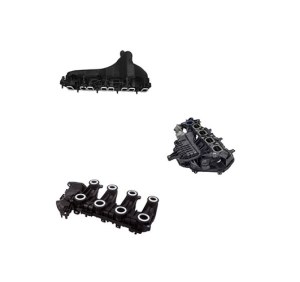The car intake manifold is a component of an automobile engine that supplies a mixture of air to different cylinders. Any failure of the intake manifold in car engine in an automobile can affect the performance of the engine brake and ignition piston engine. SDZ is pushing hard to integrate an advanced intake manifold in car engine. For more custom products, inquiry direct bulk price from engine parts manufacturer.
Features of Intake Manifold for Sale
Dual Plane Engine Inlet Manifold and Single Plane Engine Intake Manifold
Casting and Injection-Molded
Aluminium engine intake manifold, Magnesium engine intake manifold, Aluminium Alloy engine inlet manifold and Plastic engine inlet manifold.
How does the intake manifold affect your engine?
The 5.3 l intake manifold plays a crucial role in the performance and efficiency of an internal combustion engine. It serves as a critical pathway that delivers the air-fuel mixture to the engine cylinders for combustion. Understanding how the intake manifold affects your engine can help you appreciate its significance in optimizing engine performance and overall driving experience.
Air-Fuel Mixture Distribution:
The intake manifold is responsible for distributing the air-fuel mixture evenly to each cylinder of the engine. It ensures that the right amount of air and fuel is delivered to achieve the ideal stoichiometric ratio (usually around 14.7 parts air to 1 part fuel) for efficient combustion. Proper distribution of the air-fuel mixture allows the engine to generate the maximum power while minimizing fuel consumption and emissions.
Intake Air Temperature Control:
The intake manifold can influence the temperature of the incoming air. Colder air is denser and contains more oxygen molecules, which improves combustion efficiency. Many modern intake manifolds are equipped with intake air temperature sensors that allow the engine control unit (ECU) to adjust the fuel injection and ignition timing for optimal performance based on the intake air temperature.
Tuning for Performance:
In high-performance applications, the design of the intake manifold is crucial for tuning the engine's power characteristics. Different intake manifold designs can influence the engine's torque curve and power delivery at various engine speeds. For example, a longer intake manifold may increase low-end torque, while a shorter manifold may enhance high-end power.
EGR (Exhaust Gas Recirculation) System Integration:
Some intake manifolds incorporate passages for the EGR system, which reintroduces a portion of exhaust gases back into the intake manifold to reduce nitrogen oxide emissions. The integration of the EGR system within the intake manifold helps in achieving better fuel economy and meeting emission regulations.
Supercharging and Turbocharging:
For forced induction applications, such as supercharging or turbocharging, the design of the intake manifold becomes even more critical. The intake manifold must handle increased air pressure and flow rates, ensuring efficient delivery of compressed air to the cylinders.
VVT (Variable Valve Timing) Control:
In engines with variable valve timing systems, the intake manifold design can influence the effectiveness of valve timing adjustments. The intake manifold can impact the timing and duration of the valve openings, affecting engine performance and efficiency under various operating conditions.
The intake manifold serves as a vital component that directly influences engine performance, fuel efficiency, and emissions. Its role in distributing the air-fuel mixture, controlling intake air temperature, tuning for performance, integrating EGR systems, and accommodating forced induction applications make it a critical part of the engine's operation. Understanding the impact of the intake manifold on your engine can help you appreciate the complexity and engineering involved in optimizing the engine's performance and ensuring an enjoyable and efficient driving experience.
Most Required Products that you May Interest
Electronic Control Unit: Automotive position sensor
Engine Hose 1: EGR coolant hose
Engine Hose 2: Auto coolant hoses
Engine Hose 3: Automotive heater hose
Engine Hose 4: car air conditioning tube
Thermostat 1: Wax type thermostat
Thermostat 2: Map controlled car cooling system thermostat
Thermostat 3: Cooling system thermostat housing
Signs of Intake Manifold Failure
Leakage of Coolant Fluid
One of the primary signs of intake manifold failure is the leakage of coolant fluid. The intake manifold gasket, which seals the manifold to the engine block, can degrade over time due to constant exposure to heat and engine vibrations. As a result, coolant can leak from the gasket and mix with the engine's oil or escape externally, leading to low coolant levels and potential engine overheating. If you notice a drop in coolant levels or observe coolant puddles under your vehicle, it's crucial to have the intake manifold inspected promptly.
Engine Overheating
Intake manifold failure can contribute to engine overheating, especially if coolant leakage affects the engine's cooling system. A compromised intake manifold gasket can allow coolant to seep into the combustion chambers, leading to an improper air-fuel mixture and inefficient combustion. This can cause the engine to run hotter than usual, resulting in overheating. If you observe a rise in the engine temperature gauge, steam or smoke coming from the engine bay, or a persistent burning smell, it could indicate potential intake manifold issues that require immediate attention.
Poor Fuel Economy
A failing intake manifold can disrupt the air-fuel mixture balance, leading to poor fuel combustion and decreased engine efficiency. As a consequence, the vehicle may experience reduced fuel economy, requiring more fuel to cover the same distance. If you notice a significant drop in fuel efficiency or find yourself making more frequent visits to the gas station, it might be an indicator of intake manifold problems.
Location : No.9, Haohai RD, Xinbang Industrial Zone, Songjiang, Shanghai, China, 201605 Shanghai,
Contact : com sdz, 021 67891188








